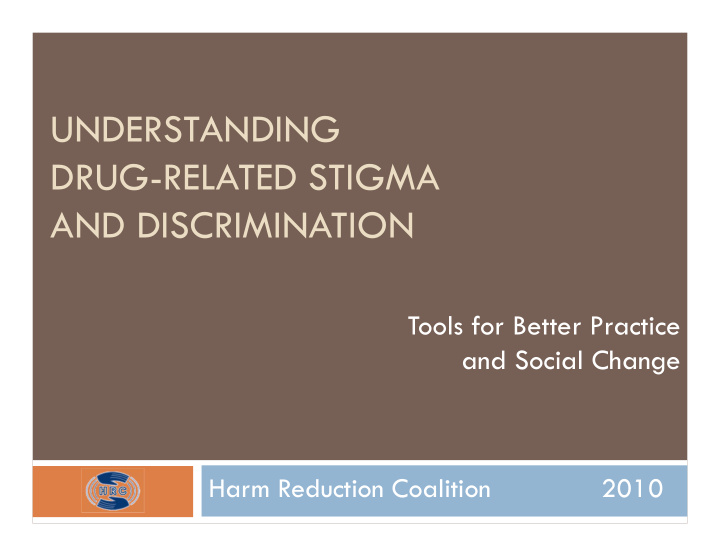



UNDERSTANDING DRUG-RELATED STIGMA AND DISCRIMINATION Tools for Better Practice and Social Change Harm Reduction Coalition 2010
Introductions � Name � Organization � How do you interact with drug users?
Goals � Identify and explore the reach of drug- related stigma. � Name strategies for confronting drug- related stigma. � Promote productive service provision that avoids stigmatizing people who use drugs.
Training Guidelines � Step up, Step Back � Non-Judgment � Talk with each other, not at each other � Agree to disagree � Confidentiality
A few basic principles… � Drug use exists along a continuum � Abstinence is one of many possible goals � Meet people “where they are at” � Drug-related harm can not be assumed � Drugs can meet important needs � Drug users are more than their drug use
What is stigma? A social process which can reinforce relations of power and control . Leads to status loss and discrimination for the stigmatized. - Link and Phelan
ACTIVITY: Forms of Stigma Stigma from individuals Institutional stigma Self-stigma (internalized) Stigma by association
Key Elements of Drug-Related Stigma Blame and moral judgment Criminalize Pathologize Patronize Fear and Isolate
Cycle of Drug-Related Stigma Julian Buchanan, Social Inclusion Unit, Glyndwr University, Stigma Internalized & Stereotypes/ Reinforced Labels Wrexham, LL11 2AW Limited Expectations/ Opportunities Roles
Implications for Providers � Willingness to access services � Relationships and trust � Assumptions � Participant risk and behaviors � Participant self-worth � Funding
Break! - 10 minute break -
Video: Labels and Language Purpose: Explore labels and language associated with drugs/drug use and their relationship to stigma Pay attention to: - Labels & Language - Themes that you see in your work with clients
Drug User Labels Gender/ Race/ Sexual Ethnicity Orientation Appearance Health and Status Stability “Drug User” Choosing How often? to abstain? Which Prescribed drugs? or street?
Language Junkies, Dope Fiends Crack-heads, Crack Babies Drug Addicts, Drug Abusers Drug Users, People Who Use Drugs Drug Use, Drug Abuse, Drug Misuse Clean and Dirty Relapse vs. Lapse
Functions of Stigma – The “3Ds” Difference Keep people out Danger Keep people away Discrimination Keep people down
Activity: Dynamics of Stigma Purpose: To explore different dynamics and consequences of stigma Keep in mind the the 3-Ds: � Difference (Keeping people out) � Danger (Keeping people away) � Discrimination (Keeping people down)
Round 1 Brainstorm ways that your institution stigmatizes drug users Think about behaviors/actions AND Why it happens (3Ds/Beliefs)
Round 2 Brainstorm ways that drug users may respond to the stigmatizing behaviors from round 1 Name behaviors/actions AND Ways stigma may be internalized
Round 3 List 3 strategies/alternatives to challenge the stigmatizing behaviors you have discussed. Either from the perspective of the institution OR As a provider helping a client
Challenging Stigma, Creating Change Individual Level Staff Community Level Level
Individual Level Language Honesty Relationships Disclosure and dialogue Education and personal development
Staff and Community Level • Training and education • Outlets for feedback Staff Level • Assessment of practices • Hiring Drug Users • Participant Advisory Boards Community • Awareness Campaigns Level • Policy and advocacy • Events
Release Campaign
Recommend
More recommend